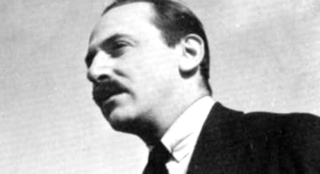
Nathanael West was an American writer and screenwriter. He is remembered for two darkly satirical novels: Miss Lonelyhearts (1933) and The Day of the Locust (1939), set respectively in the newspaper and Hollywood film industries.
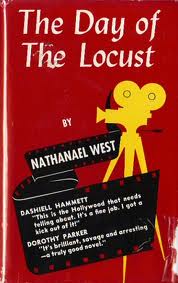
The Day of the Locust is a 1939 novel by American author Nathanael West set in Hollywood, California. The novel follows a young artist from the Yale School of Fine Arts named Tod Hackett, who has been hired by a Hollywood studio to do scene design and painting. While he works he plans an important painting to be called "The Burning of Los Angeles", a portrayal of the chaotic and fiery holocaust which will destroy the city. While the cast of characters Tod befriends are a conglomerate of Hollywood stereotypes, his greater discovery is a part of society whose "eyes filled with hatred", and "had come to California to die". This undercurrent of society captures the despair of Americans who worked and saved their entire lives only to realize, too late, that the American dream was more elusive than they imagine. Their anger boils into rage, and the craze over the latest Hollywood premiere erupts violently into mob rule and absolute chaos.
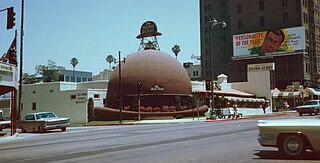
Brown Derby was a chain of restaurants in Los Angeles, California. The first and best known was shaped like a derby hat, an iconic image that became synonymous with the Golden Age of Hollywood. It was opened by Wilson Mizner in 1926. The chain was started by Robert H. Cobb and Herbert K. Somborn in the 1920s. The original Brown Derby restaurants had closed or had been converted to other uses by the 1980s, though a Disney-backed Brown Derby national franchising program revived the brand in the 21st century. It is often incorrectly thought that the Brown Derby was a single restaurant, and the Wilshire Boulevard and Hollywood branches are frequently confused.
The culture of Los Angeles is rich with arts and ethnically diverse. The greater Los Angeles metro area has several notable art museums including the Los Angeles County Museum of Art (LACMA), the J. Paul Getty Museum on the Santa Monica Mountains overlooking the Pacific, the Museum of Contemporary Art (MOCA), and the Hammer Museum. In the 1920s and 1930s Will Durant and Ariel Durant, Arnold Schoenberg and other intellectuals were the representatives of culture, in addition to the movie writers and directors. As the city flourished financially in the middle of the 20th century, culture followed. Boosters such as Dorothy Buffum Chandler and other philanthropists raised funds for the establishment of art museums, music centers and theaters. Today, the Southland cultural scene is as complex, sophisticated and varied as any in the world.

Chasen's was a famous restaurant frequented by film stars, entertainers, politicians, and other dignitaries in West Hollywood, California, located at 9039 Beverly Boulevard on the border of Beverly Hills. It opened for business in 1936 and was the site of the Academy Awards party for many years. It was also famous for its chili. Elizabeth Taylor had several orders of Chasen's chili flown to the set of Cleopatra in 1963 while filming in Rome, and to Oroville, California during the filming of The Klansman in 1974.

Nancy Silverton is an American chef, baker, restaurateur, and author. The winner of the James Beard Foundation's Outstanding Chef Award in 2014, Silverton is recognized for her role in popularizing sourdough and artisan breads in the United States.
Munawar Musso (1897–1948), was an Indonesian politician.
Frank Edgington Fenton was an American writer of screenplays, short stories, magazine articles, and novels.
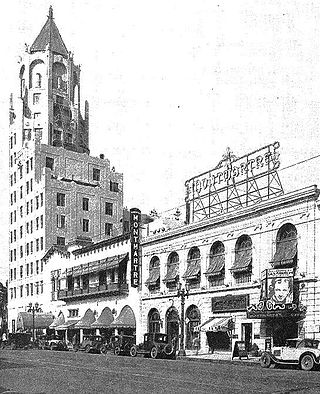
Café Montmartre was a restaurant and nightclub on Hollywood Boulevard at Highland Avenue in Hollywood, Los Angeles, California, US. Opened in 1923, it became a "worldwide center for celebrity and nightlife" during the 1920s and a place where tourists would visit to try to break into Hollywood.
Carl L. Maston was an American architect known for his mid-century modern architecture.
George Caryl Sims, better known by his pen names Paul Cain and Peter Ruric, was an American pulp fiction author and screenwriter. He is best known for his novel Fast One, which is considered to be a landmark of the pulp fiction genre and was called the "high point in the ultra hard-boiled manner" by Raymond Chandler. Lee Server, author of the Encyclopedia of Pulp Fiction Writers, called Fast One "a cold-hearted, machine-gun-paced masterwork" and his other writings "gemlike, stoic and merciless vignettes that seemed to come direct from the bootlegging front lines."

The Hollywood Roosevelt Hotel is a historic hotel located at 7000 Hollywood Boulevard in the Hollywood district of Los Angeles, California. It opened on May 15, 1927, and is the oldest continually operating hotel in Los Angeles.

Sunset Marquis Hotel is a luxury hotel in West Hollywood, Los Angeles County, California. It is owned by George and his son Mark Rosenthal, and located at 1200 Alta Loma Road, and situated just off the Sunset Strip. Known for its celebrity clientele, especially musicians and people in the film industry, the hotel offers 100 suites and 52 villas located on 3 1/4 acres. Cavatina, the hotel restaurant, is popular for an expansive al fresco dining area and Bar 1200 was the original Whiskey Bar. NightBird Recording Studios, a professional recording studio in the lower level of the hotel is very popular with professional musicians and many GRAMMY winning songs have been recorded here. The hotel is also home to the Morrison Hotel Gallery which features fine art photography of rock legends. As of October 2017 room rates range from $350 to $10,000 per night.
Stanley Rose was an American bookseller, literary agent, and raconteur, whose eponymous Hollywood bookshop, located adjacent to the famous Musso & Frank Grill restaurant, was a gathering place for writers working or living in and around Hollywood. Rose's most notable literary associates were William Saroyan, to whom he was variously a friend, a drinking and hunting companion, and a literary representative; and Nathanael West, whose 1939 novel The Day of the Locust owed much of its “local color” to its author's acquaintance with Rose.

A taco stand or taquería is a food stall, food cart or restaurant that specializes in tacos and other Mexican dishes. The food is typically prepared quickly and tends to be inexpensive. Many various ingredients may be used, and various taco styles may be served. Taco stands are an integral part of Mexican street food. Tacos became a part of traditional Mexican cuisine in the early 20th century, beginning in Mexico City, as what had been a miner's snack began to be sold on street corners in the city. Shops selling tacos have since proliferated throughout Mexico and other areas with a heavy Mexican culinary and cultural influence, including much of the Western United States and most other larger American cities. More typical taquerías specialize in tacos, as expected, but in some localities it can be used to refer to restaurants specializing in burritos, where tacos themselves are less of a point of emphasis.
Ben Frank's was a restaurant in West Hollywood, California, opened in 1962 by Arthur Simms and Bob Ehrman. The location, surrounded by the famous nightclubs of the Sunset Strip, led to a celebrity clientele, and the 24-hour restaurant became a popular late night destination. The distinctive googie architecture and eye-catching neon sign helped attract musicians like Jim Morrison and Frank Zappa, as well as patrons of the nearby music venues. The youthful patrons that frequented the restaurant inspired the producers of the Monkees TV show to place an ad seeking "spirited Ben Frank's types" when casting the show in 1965.
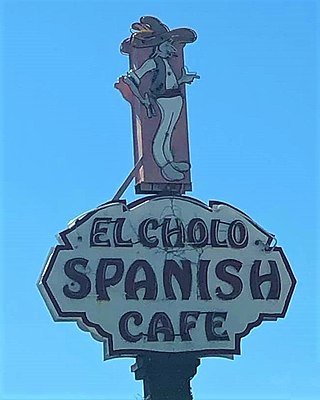
The El Cholo Spanish Cafe is a Los Angeles restaurant serving Mexican food. Founded in 1923, the restaurant is credited with the introduction of the burrito to the United States in the 1930s. The restaurant has expanded to a chain with six locations in Southern California. It celebrated its 100th anniversary in 2023.












